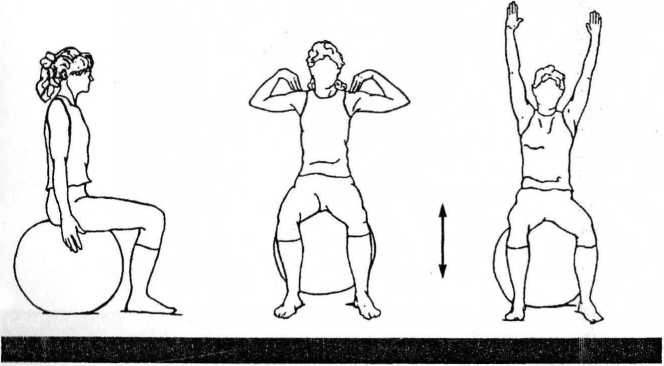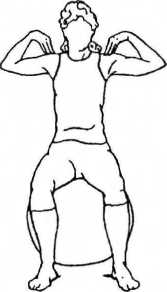img037

Datę Name.
Shoulder Taps with Reach Up 1:10
Starting Position: Sit correctly on bali in optimal posturę. Touch hands to shoulders and lift elbows to shoulder height.
Movement: Raise hands up toward ceiling as high as possible and then touch hands to shoulders. Add bouncing in tempo.

Breathing: Monitor heart ratę. If winded, bounce less vigorously.

Modificatlon:
1. Raise arms only as far as comfort allows.
2. Only raise one arm at a time.
3. Touch bali or stable object with other hand for balance assistance. Progression:
1. Increase speed of arms, size of bounce and tempo of bounce.
2. Add light weights to wrist or hands.
Beats/min_ Weights_
Ropeat__Times Do_Times/day
Purpose/Goal:.
i '< immtnta: By moving the arms, Ihe slability ot the spine is further challenged and heart ratę will nim Incroase. The arm movements, combined with the rhythmic bouncing, will challenge i '»>idlnatlon,, motor planning and balance.
'i ■ I im», liy Joann* Posnar-Mayer, PT
Asymmetrical Arms_ 1:11
Starting Position: Sit correctly on bali in optimal posturę. Touch hands to shoulders with elbows out to side. Lift elbows to shoulder height.
Movement: Fteach one arm up and one arm out. Return hands to shoulders and alternate sides. Add bouncing to tempo.


CAUTIOH: KEEP FĘET PLANTED ON FLOOR. KEEP SHOULDERS DOWN.

Breathing: Monitor heart ratę. If winded, bounce less vigorously.
Modification: Reach arms only as far as comfort allows.
Progression:
1. Increase speed of arm swing, size of bounce and tempo of bounce.
2. Add light weights to wrists or hands.
Beats/min_ Weights_
Repeat_Times Do_Times/day
Purpose/Goal:.
Comments: Asymmetrical arm movements will add challenge to trunk stability, balance and coordination.
©1995 by Joannę Posner-Mayer, PT
47
Wyszukiwarka
Podobne podstrony:
img067 Datę. Name.Half Sit-Up with Obligues-Spinal Stability Starting Position: Sit correctly on bal
img035 Datę_ Name.Arm Swing with Bounce i:6 Starting Position: Sit correctly on ba
img036 Datę_ Name Overhead Clap with Bounce 1:8 Starting Position: Sit correctly o
77540 img044 Datę Name.Cossack Dance _ t; 22 Starting Position: Sit correctly on bali in optimal pos
55870 img042 Datę. Name. Starting Position: Sit correctly on bali In optimal posturę. Begin Basic Bo
img034 rnmm ■ : .• 0 Datę Na meTight Arm Circles with Bounce Starting Position: Sit correctly on bal
img045 Datę Name.Fuli Jumping Jacks 1.24 Starting Position: Sit correctly on bali
img043 Datę_ Name. March-Arm and Leg 1.20 Starting Position: Sit correctly on bali
więcej podobnych podstron